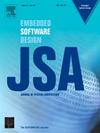SADDLE: A runtime feedback control architecture for adaptive distributed deep learning in heterogeneous GPU clusters
IF 4.1
2区 计算机科学
Q1 COMPUTER SCIENCE, HARDWARE & ARCHITECTURE
引用次数: 0
Abstract
Adaptive training in heterogeneous GPU clusters requires more than isolated heuristics—it demands a real-time, feedback-driven control system. SADDLE is a self-adaptive framework that unifies global batch scaling, local throughput balancing, and transient straggler mitigation into a fully coordinated runtime. It combines scaling guided by the Gradient Noise Scale (GNS), z-score detection over Exponentially Weighted Moving Average (EWMA)-smoothed iteration times, and responsiveness tuned via a Proportional–Integral–Derivative (PID) controller into a single, event-driven control loop. Across vision and language tasks, SADDLE improves training time by up to 2.84×and accuracy by up to 5.26% over strong baselines, while maintaining under 6% runtime overhead. This reframing positions adaptive training as dynamic system regulation, enabling deep learning frameworks to self-optimize under real-world heterogeneity.
鞍:一种用于异构GPU集群中自适应分布式深度学习的运行时反馈控制架构
异构GPU集群中的自适应训练需要的不仅仅是孤立的启发式算法——它需要一个实时的、反馈驱动的控制系统。SADDLE是一个自适应框架,它将全局批处理扩展、本地吞吐量平衡和瞬态掉队者缓解统一到一个完全协调的运行时中。它结合了梯度噪声标度(GNS)引导的缩放,指数加权移动平均(EWMA)平滑迭代时间的z分数检测,以及通过比例积分导数(PID)控制器调整到单个事件驱动控制回路的响应性。在视觉和语言任务中,SADDLE将训练时间提高了2.84×and,准确率比强基线提高了5.26%,同时保持在6%以下的运行时开销。这种重构将自适应训练定位为动态系统调节,使深度学习框架能够在现实世界的异质性下进行自我优化。
本文章由计算机程序翻译,如有差异,请以英文原文为准。
求助全文
约1分钟内获得全文
求助全文
来源期刊

Journal of Systems Architecture
工程技术-计算机:硬件
CiteScore
8.70
自引率
15.60%
发文量
226
审稿时长
46 days
期刊介绍:
The Journal of Systems Architecture: Embedded Software Design (JSA) is a journal covering all design and architectural aspects related to embedded systems and software. It ranges from the microarchitecture level via the system software level up to the application-specific architecture level. Aspects such as real-time systems, operating systems, FPGA programming, programming languages, communications (limited to analysis and the software stack), mobile systems, parallel and distributed architectures as well as additional subjects in the computer and system architecture area will fall within the scope of this journal. Technology will not be a main focus, but its use and relevance to particular designs will be. Case studies are welcome but must contribute more than just a design for a particular piece of software.
Design automation of such systems including methodologies, techniques and tools for their design as well as novel designs of software components fall within the scope of this journal. Novel applications that use embedded systems are also central in this journal. While hardware is not a part of this journal hardware/software co-design methods that consider interplay between software and hardware components with and emphasis on software are also relevant here.
 求助内容:
求助内容: 应助结果提醒方式:
应助结果提醒方式:


